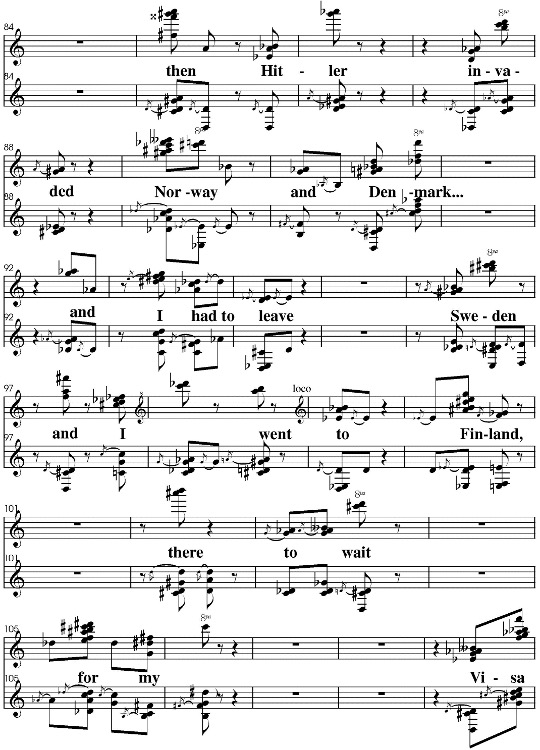Weaving Meaning through the Arts - Across, Along and Beyond
Steven McAlpine, University of Maryland, Baltimore County
Heidi Upton, St. John's University
Heather Van Uxem Lewis, Rutgers University
Greetings, Integrative Pathways Readers. Recently, my colleagues Steven McAlpine, Heather Van Uxem Lewis and I (Heidi Upton) met to reminisce about an Arts and Humanities Section workshop we led at the AIS Annual Conference in Amsterdam, Netherlands back in 2019. It’s been a while since then, but our memories of the workshop and our time there are still very much alive. We’re sharing parts of that conversation about it with you here, bringing you back to that time along with us.
Our workshop was called Weaving Meaning through the Arts – Across, Along and Beyond.
This is how we described it in our proposal:
Wayfaring, a way of “carrying on” that seeks non-routinized interactions with the environment, requires an initial sense of perspective (a knowing where we “are”). It departs from other forms of disciplinary research or investigation in asking the traveler to drop expectations and fixities in what is commonly believed to be fact or truth. Wayfaring asks that we embrace a willingness to inhabit space in order to make new connections across boundaries and expand initial perspectives to include new knowledge. Using Ingold’s anthropological wayfaring guide, set forth in his book “Lines: A Brief History”, we seek to share how this approach of exploration, connection, and assessment can cross physical and political boundaries by weaving together lines of thinking, community mapping, and global routes of communication.
And now, here are edited excerpts from our conversation:
Heidi: So great to be in touch with you, my dear friends and partners in Arts and Humanities crime. We have worked together for a while now – I still remember that workshop we did at the AIS conference in Baltimore in 2017. We were exploring the idea of The Wave, then, weren’t we, and how that motion and movement is present in so many different contexts? That was great fun.
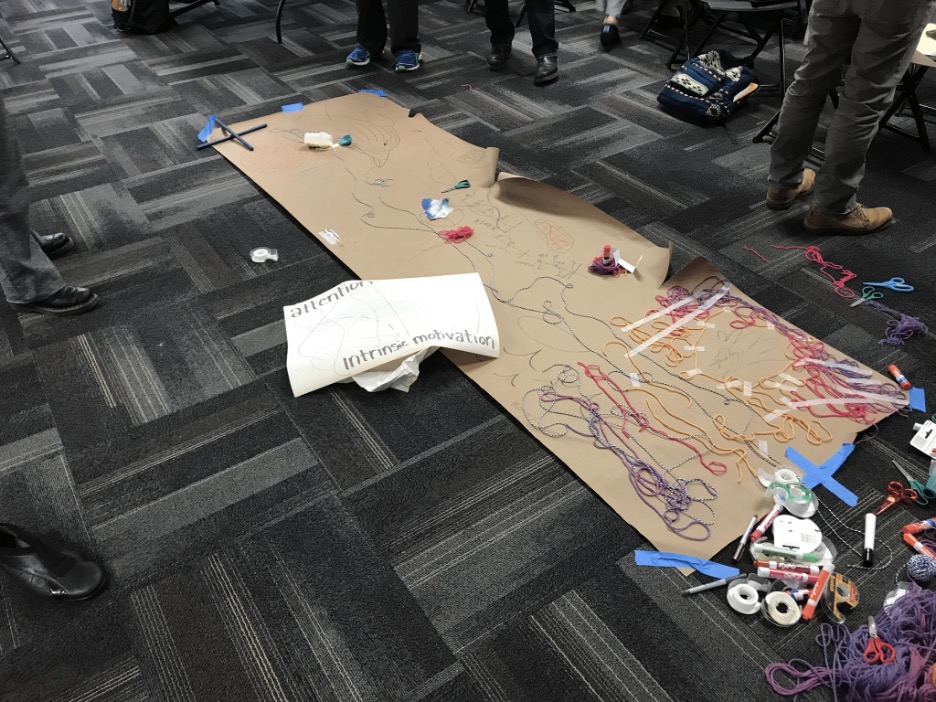
[SM] Yes, I connected our “waves” theme to my interest in musical instrument design, and wanted to explore the wave properties involved when a musical instrument changes pitch. I used the example of the “drumbone” instrument invented by the Blue Man Group.
Heidi: Oh yes! And remember that amazing video we shared depicting resonance and sound? Participants were quite inspired by that, as I recall.
Anyway, needless to say, a lot has happened since that workshop and most importantly for our conversation here, we are particularly remembering today our Arts and Humanities workshop experience in Amsterdam! So much to think about, to reflect upon. When I think back to that workshop, the theme of which was Wayfaring, I remember the very moment that started the idea for me. It happened when I was sitting in my car one day in the spring of that year, just having parked my car on my campus. I was about to turn off the ignition when this wild music came on the radio – I couldn’t believe what I was hearing. Can I say that it “blew my mind”, because it was that kind of “wow” moment for me. I actually called the radio station (WKCR-FM in NYC) to ask the announcer the name of the work. The piece was Voices and Piano by Peter Ablinger and it’s a series of song pieces (although nobody is singing) that puts into juxtaposition words spoken by well-known (for the most part) figures and the sounds of a piano, notated carefully to respond to, reflect, mimic at times these spoken words.
In the words of the composer: the piano is not really accompanying the voices: the relation of the two is more a competition or comparison. Speech and music are compared. (https://ablinger.mur.at/voices_and_piano.html)
For those who might be interested in hearing some of this work, here’s an excerpt of the notation of Bertolt Brecht speaking, in the piano score:
Listening to the piece, that day in the parking lot, I became aware of my brain doing things I hadn’t noticed before. I was cognitively hopping back and forth between different ways of knowing, trying to make sense of what I was hearing, through the properties of music and speech.
As a musician, I am used to playing music that has in it multiple voices and am adept at listening as well, picking apart the immense variety of instrumental sounds and actions, in music of all kinds. Listening to Ablinger, though, with musical language in dialogue with…well…spoken language…I was aware of jumping cognitively between the two and finding evidence of each in the other. This experience differed from the usual “music with lyrics” model. Ablinger uses speech that was not intended as lyrical text, and analyzes its qualities through the use of musical processes.
The fact that some of the pieces in Voices and Piano were in a language I understand – English – and some in languages I don’t understand or only have rudimentary knowledge of, added another layer or line of mental activity. If I couldn’t understand the language, I became more sensitive to the musical elements in the language – not distracted by what was being said, but when I understood the language I then became aware of a third “line” to negotiate. This athletic way of processing information reminded me of interdisciplinary thinking, as one leaps across boundaries of information and meaning. So I brought this experience to our attention. I thought it would be an idea with which we could play – how the mind makes sense of familiar and unfamiliar, unexpected pieces of information that swirl in the mind at the same time. In other words, when I made the connection between this kind of jumping around and Ingold’s idea of wayfaring (I had just then begun to read Ingold’s writings), I knew we needed to explore the idea in some way.
The workshop that emerged combined our three approaches to the same ideas. My “module” focused on the Ablinger piece, and how the mind negotiates musical ideas and those that belong to language in juxtaposition. Steven, your module focused on the sustainable design work you and your students do with kinetic sculptures, using upcycled materials. And Heather, as a photographer, you explored the idea of self-censorship in accessing the forbidden, the unreflected, and the unnoticed through photographs and cell phone photography.
What are your recollections of the beginning beats of our creative process?
Heather: When we first started considering the ideas from Ingold and the connections to Ablinger’s work, we were in a way, doing what we set out to create for others – wayfaring. There is a certain excitement involved in creating a new experience. Exploring the ideas of wayfaring, community, paths, awareness, and engagement opened up the gift of exploration in an intentional and meaningful way. Meaning that we were not doing “research” within tightly present parameters. In fact, working in a decidedly interdisciplinary fashion almost demanded getting away from traditional research and explanations. This freedom lent an air of expeditionary creation. The more we opened up to our own interests, the more we were able to see the connections and flow of ideas between the different expressions and experiences we were each offering.
Our process as a collaborative was and is an open exploration of listening to each other’s experiences and engaging with what makes us curious. It is akin to an expedition, but one where we each bring our ways of seeing and experiencing the world to illuminate new spaces and ideas. Much like the labyrinth Ingold refers to as a “powerful image of movement and wayfaring in a world of the dead that is believed to lie beneath the surface of the world of quotidian experience (p. 55),” we used our interactions to seek the knowledge of the labyrinth of the everyday to reveal something that exists in plain sight.
Steven: Heidi, when you proposed this idea and shared the Ablinger piece, I must admit that at first I thought you had gone off the deep end. My first reaction to Ablinger was, “These things do not go together.” But some of my favorite experiences with the performing arts have taken me out of my comfort zone (so that I feel the thrill of “going off the deep end”). As I reflected on my reaction to Ablinger, I realized that it served as a musical metaphor for the challenge of building a kinetic sculpture where the primary challenge of integration is to bring art and engineering together. Often, in our process of designing in teams, ideas and materials do not “go together.”
Heidi, you also shared a chapter from Ingold’s Lines book in order to introduce us to the concept of wayfaring. One section in particular resonated with my experience as a teacher of sustainable design: “As he proceeds, however, the wayfarer has to sustain himself, both perceptually and materially, through an active engagement with the country that opens up along his path.” (78) After reading that chapter (entitled “Up, Across and Along”), I began to see our design process as a kind of wayfaring on our university campus as students searched for recycled materials to incorporate into sculptural and engineering designs.
What do you remember wanting to share with the attending group? What did you hope they might experience?
Heather: There is a section in “Lines” where Ingold addresses lines as representative of humanity and culture versus nature, straight and not straight, respectively (p. 159). The straight lines can in some ways be seen as progress and innovation where non-straight lines are organic — natural. I wanted the participants in the workshop to experience exploration in both the straight line – created workshop experience – as well as the non-straight line of organic interactions with others, the materials, and the ideas being offered. Having a new experience that gives space for insight or even just sheer pleasure can influence how we each navigate through our daily lives and interpret the experience of wayfaring.
Steven: I wanted participants to experience the contrast between wayfaring – exploring the materials and structures and ideas in their immediate environment – and the type of point to point traveling that brought them to the AIS conference in Amsterdam. Ingold makes the distinction between a “meshwork” of overlapping lines (Figure 3) in wayfaring versus a “network” of straight point to point connections (Figure 4) (84), a network through which we all traveled to arrive at the conference. As I watched our workshop participants move their prototypes to the stage in our workshop, I was struck by the meandering routes they took to wind through people and tables. If we were to trace these lines of movement with a view from above the room, those lines of movement would resemble Ingold’s meshwork diagram.
In general, our workshop asked participants (and ourselves!) to bring the notion of “finding one’s way” into a variety of contexts, all of which tied together in the end.
Here are two visuals, borrowed from Ingold’s book that helped us present the difference between “occupying” knowledge and “inhabiting” knowledge.
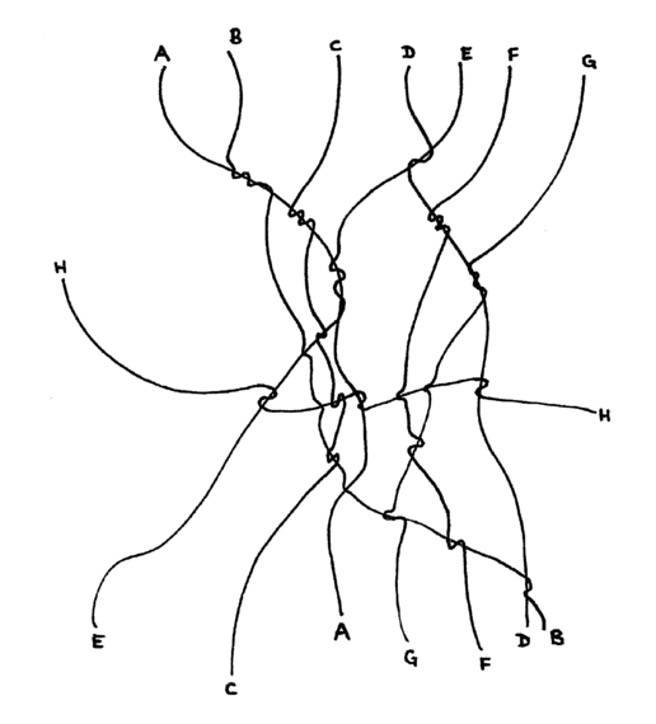
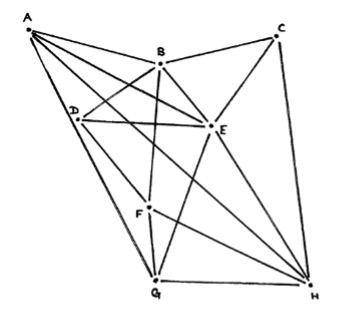
Heidi: And I wanted to bring participants to the moment of disjunction one can experience, listening to the Ablinger, and to make connections between that means of travel and similar journeys we make when working integratively. What comes next, when one encounters and sometimes must carve one’s way through unfamiliar terrain?
I’d like to take a moment, though, just to think about the space we were given for our workshop. It was, in my opinion, stunning. I remember explaining to Linda deGreef the kind of space we needed for this workshop and the ways in which we wanted to have people interacting. She listened, in such an amazing way.
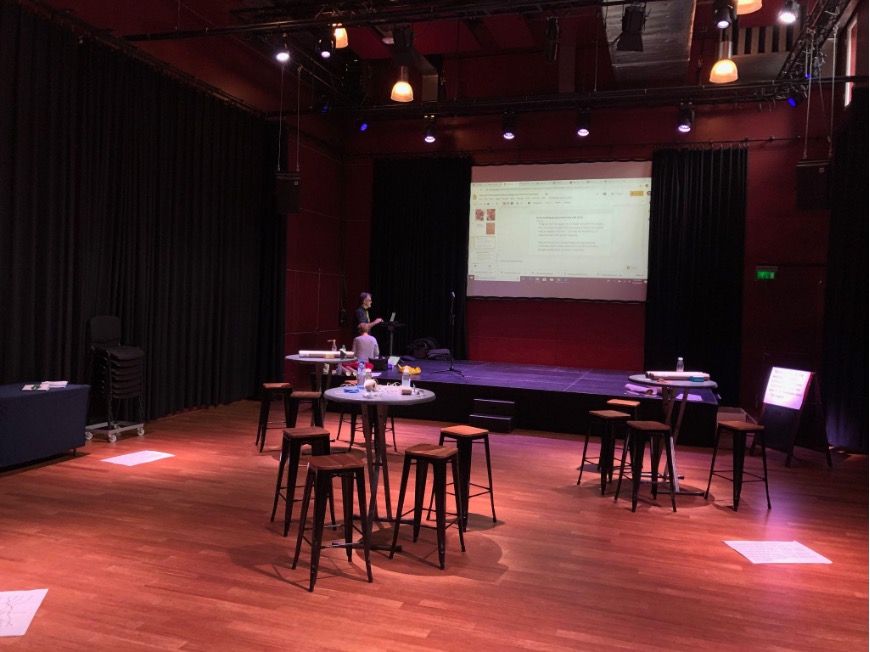
When we walked into that incredible space, what did you both think?
Steven: I loved that performance space – it had the “spatial semiotics” of collaboration and activity, rather than of passively listening to a lecture, but it was versatile enough to also serve as a gallery where we could post quotes, a non-linear exploratory space. When I watched the video of my workshop module recently, I appreciated the “wayfaring” of each prototype builder as they moved their piece through/around the tables to the stage.
Heidi: The workshop space invited collaborative work, giving us and our participants room to move around, to gather, to make things. At first, it was up to us to arrange things though, and it was with a sense of possibility that we proceeded – thanks to the room we were in. And, yes, it contrasted so much with spaces we usually “learn” in, with rows of desks and seats that sometimes don’t even move.
Leaning back into memories of the workshop, I remember asking folks to create definitions in both musical concepts and concepts associated with language. A strategy at work here for me, in preparing participants to “hear” the Ablinger pieces, was to establish in the group some common ground – a way of thinking about sound and having a communal understanding of certain concepts. The quest in crafting such workshops for all of us, I think, is having a vision of destination, and then (backwards) mapping the possible paths to this ultimate understanding. And in each of our modules, experiential work was (and is) a key form of inquiry – having participants actually manipulate materials, walk around (sometimes metaphorically, sometimes actually) inside ideas, working together. For me, it took the form of participants listening to each other, mapping how a partner’s voice sounded, and how this combined and informed the listening as they made sense of what they heard. It was only after such investigation – speaking/listening/mapping – that an encounter with excerpts from the work of art occurred. There were handouts regarding these ideas, after initial ones generated by participants. With these “definitions” in place, we could be sure we were talking about the same thing, as the activities in my part of the workshop proceeded.
We all worked with materials, didn’t we? It’s part of our “m-o”. Do either of you want to talk about materials here?
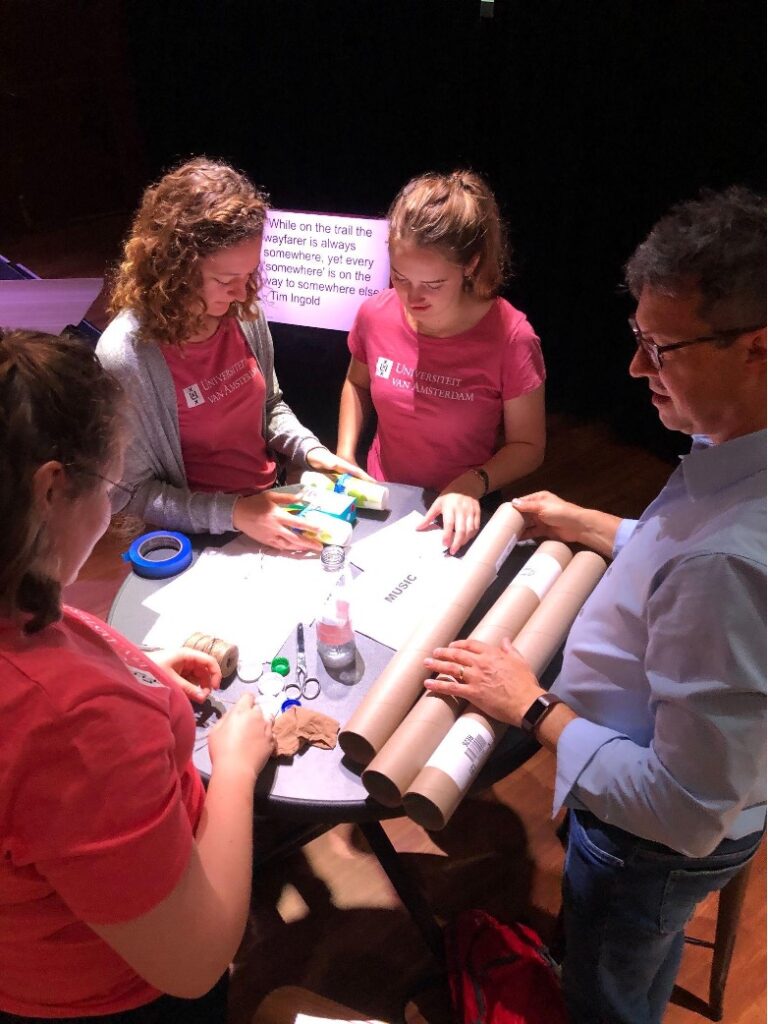
Heather: Materials are essential to how we work. In order to make a workshop like this truly engaging, we brought in various materials, objects, and all sorts of electronic files. Some of the pieces we brought in were local. Heidi and Steven, this was a key part of your explorations. Using the medium of photography as reflection at the end, I had the benefit of working with the remnants and evidence left around the space in the wake of the previous overtures. It was impossible to just talk people through the ideas. This is because participation and experiential knowledge are key to knowing and understanding. You can talk about art and creating all you want, but until you engage with the creation in line with the ideas presented, you can only imagine. The experience of doing, listening, creating, and engaging with others is a part of the gift of wayfaring.
Heidi: I couldn’t agree more, Heather. It is in the “doing”, the “making”, that we begin to make meaning, that we begin to build knowledge.
Steven: My primary concern about the prototyping section of our workshop, which was my module, was whether we would be able to bring and gather enough materials for the session. I was limited in terms of what I could bring with me for my trip from Baltimore to Amsterdam – I think I brought string and duct tape, hoping that TSA wouldn’t pull me out of the line for questioning. But I was relieved to find that the conference organizers were very helpful with collecting recycled materials, handing us a box full of things that proved to be perfect for a quick, low tech prototyping session.
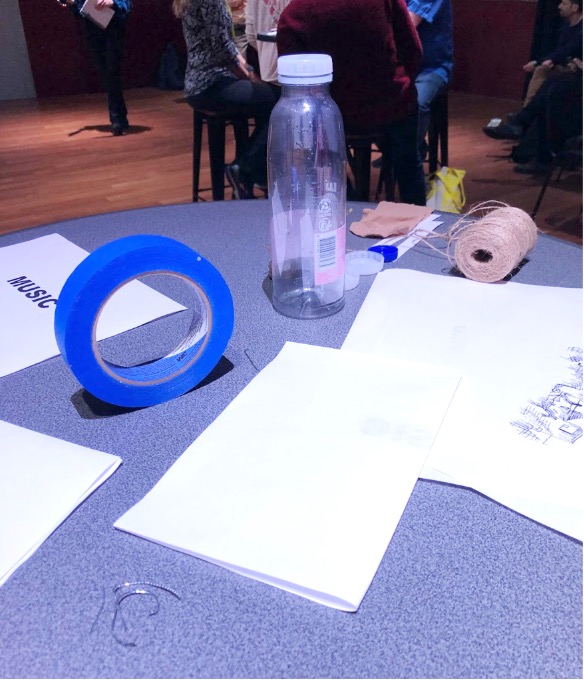
Heidi: Just sayin’, I brought that blue tape all the way from home…it’s a “must have” material for any sort of active creative workshop! And, Heather, you were the one who made and shlepped with you our fabulous wall text pieces, excerpted from Ingold’s book.
Heather: Yes, and when we walked into the space I remember feeling a sense of urgency. It is one thing to plan out a workshop and organize the flow, but it is another thing to implement the ideas in the actual space. Our work is relatively contextual and requires interaction with the environment. While we knew we were going to manipulate the space to a certain extent with quotes, slides, music, and spacing, how all of this was going to come together and what it would look like required us to let go of having control over every aspect of preparation. This is, in part, wayfaring in practice. Being comfortable in wayfaring and intuitive exploration (not having total control over what happens) is necessary for this type of workshop to be successful.
Our job as leaders is to convey comfort – or at least perceived comfort – and it is conveyed to the participants through the ease in our voices, the open adaptability to their comments and (inter)actions, as well as in our gestures. There are so many unknowns/unexpecteds in our workshops that we must be in the flow and in a creative state of wayfaring, ready for anything, while keeping a sense of leading and direction, that it becomes a balancing act of freedom and focus, but on adrenaline.
With that said, I found that when I entered the space, I entered as an artist, looking for the cues and signs the space was giving to us as fuel and inspiration. There is a sense of wonder and possibility about what could be created in a small creative blackbox space, but with limited time and the pressure of performance expectations, the urgency takes control somewhat and shifts the narrative. This is exciting for me to experience as I thrive in situations where I must rely on a combination of my knowledge and experience in arts, art making, leading creativity workshops and the like, all mixed with intuitive interactions and the flexibility of wayfaring. The part that I find requires the greatest amount of focus and attention is creating this space with two other artist-educator-professionals (you two) and staying in that balanced space. So there is the open and intuitive part, there is the planned experience, and then there is how we work with each other honoring the various aspects of each other’s gifts. All of this affects how I/we experience the space when we first encounter the possibilities of what the space has to offer.
Steven: I was excited to be in a black box performance space with a stage rather than in a conventional conference room, which is typically set up with rows of desks and chairs facing a presenter and screen. The space immediately gave me the impression that we would not be lecturing to attendees in rows; that instead our colleagues would be there to co-create and collaborate and to share ideas. The room also provided a gallery space where we could hang quotes and diagrams, and our lighting technician helped us to highlight these artifacts. We had the freedom to set up tall round tables and stools so that attendees could congregate in small groups, encouraging conversation and collaboration, but also allowing for plenty of space between groups for all of us to “wander” in a wayfaring way as the workshop unfolded. I led an activity where participants created prototypes of an interesting moving object that they encountered during their visit to Amsterdam – a kinetic challenge where groups would be asked to demonstrate how the object moved and then to allow other participants to guess what the prototype was. I enjoyed wandering between tables, listening to group discussions and watching them transform the materials at hand (cardboard tubes, plastic bottles, construction paper, string, plastic cups…) into a protoype. We had intentionally put shared tools on a table in the center of the room to encourage movement and coordination between groups. In retrospect, Ingold’s commentary on wayfarers sheds light on our transformation of that black box space:
“Wayfarers, however, are not failed or reluctant occupants but successful inhabitants. They may indeed be widely traveled, moving from place to place – often over considerable distances and contributing through these movements to the ongoing formation of each of the places through which they pass. Wayfaring, in short, is neither placeless nor place-bound but place-making.” (104)
In that space we all became performers and explorers: we facilitated and improvised; members of small groups searched for materials and tools, then moved their prototypes to the stage; and we asked their colleagues to solve their kinetic riddle. I was fascinated that participants were able to recognize the moving object that each prototype represented on the first or second try; remember that these prototypes were discussed and built in fifteen minutes! Somehow this cross disciplinary and cross cultural experiment communicated the shared experience of our wayfarers.

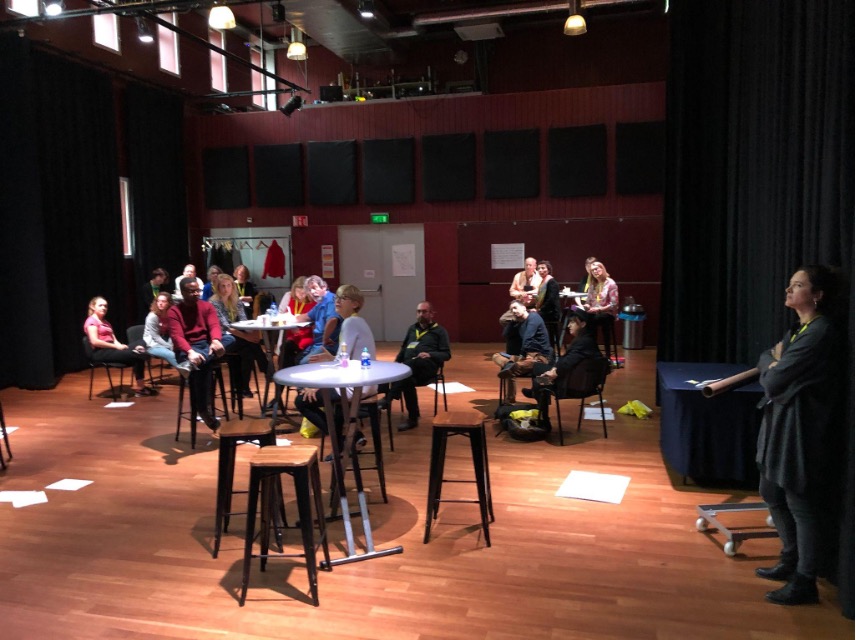
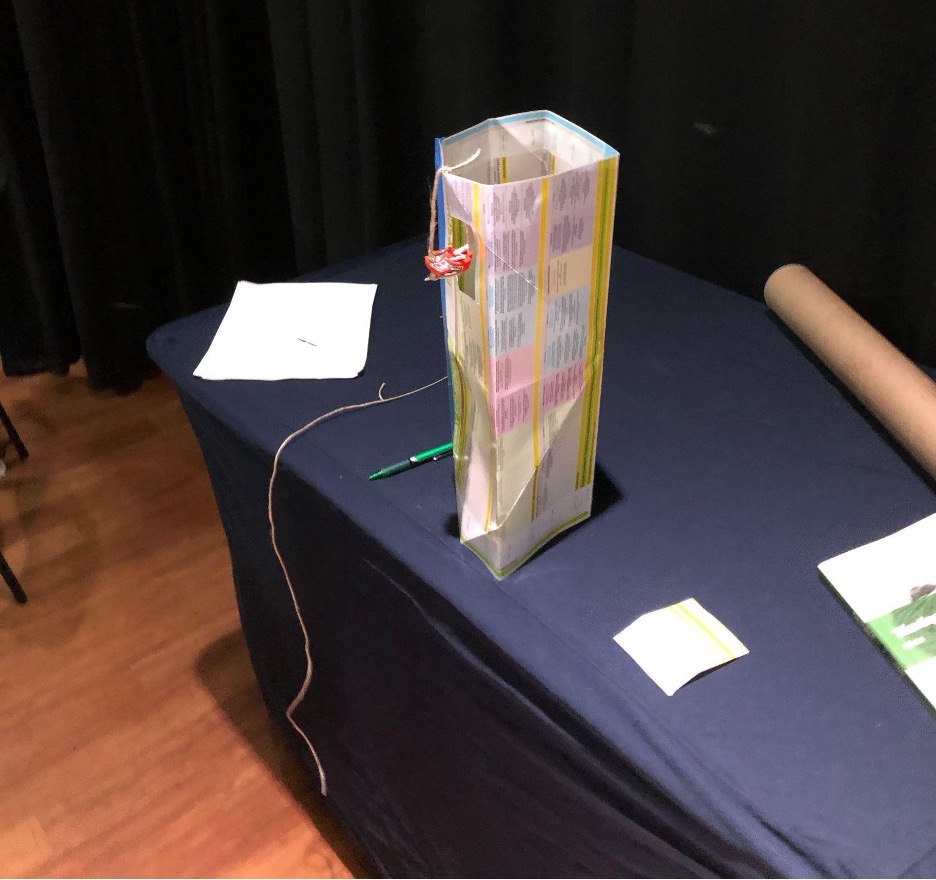
And what about final steps in the workshop?
Heidi: The most important element in active and participatory work of this kind, is the time left for reflection, for processing what has happened, do you agree? I recall that this portion of the workshop was quite rich, with participants voicing their “take” on wayfaring.
Steven: Heidi, I was struck by your final question for participants: “How are you walking out this door with a new sense of wayfaring?” Some answers came from participants at this point in our session:
- “Pushing against the rationality of google maps (assuming that you usually want to go straight – very quickly- from A to B).”
- Noticing one’s “internal reflection” as one moves through a campus or city.
- “Being mindful” – aware of where you are.
- “We need more time.”
- “Being open to wonder – to see something and just feel its beauty and be in that moment.”
You also asked what barriers existed that might inhibit our wayfaring. I discovered that my answers came after the workshop as I walked around Amsterdam: in order to make time for some wayfaring, I pushed back against the rationality of the conference schedule, and simply gave myself permission to wander without an agenda. Fears that my time was short, or that I would get lost, were drowned out by the thrill of exploring a beautiful city with magnificent views from its ornate bridges over canals. My wayfaring provided a moving contrast to the necessary timetable that we observed in our workshop with creative constraints such as “you have fifteen minutes to build a prototype” or “we only have a few minutes left to hear your reflections on this workshop.” After spending my day moving efficiently from point A (hotel) to point B (workshop space), I shifted gears after dinner and allowed myself to be drawn toward beautiful structures, lights, and sounds. As I went on this “walkabout,” as my friend Bob from Australia calls it, I completely lost track of time, and felt a peaceful sense that my internal “taskmaster” had fallen asleep. How invigorating to find myself “open to wonder” and to be able to receive the beauty around me!
Heidi and Heather, I am curious how the workshop gave you a new sense of wayfaring?
Heidi: There’s something in me that really hates feeling lost. I like knowing where I am, at least in physical space, ironically. And yet it is precisely this state of being – not knowing quite where one is – that contributes to discovery. As uncomfortable as wayfaring might be at times, the outcome always seems to be a plus, a positive. I remember having to find an apartment by one of the canals, while in Amsterdam, to meet a friend of a friend who lives there. I did find it with not too much trouble, but getting back to the hotel from there was quite another story. I got on a bus, and the bus driver forgot, despite his promise, to tell me when to get off. As a result I had no idea where I was at all. I found out more about Amsterdam that day than on all the other days when I very carefully traced the route from hotel to University campus, from A to B. I definitely wayfared my way home that day, and learned that while it’s not always easy, letting go a bit leads to unexpected, and lasting (!) learning. Think even now about how the pandemic has forced some of us to wayfare ourselves into online learning, like it or not! This past year, I have figured out how to reach into those little faces in little squares on the screen, finding connections with students I never thought I could make.
How similar is this to the interdisciplinary research process where we’re not quite sure where we’re going? And isn’t this resonant with any work in the arts, when one is creating something, but not quite sure what the result will be? As for our workshop, we sure didn’t know where we were headed when we started out. Now, that’s fun. And, in a very real sense, this kind of work is never complete. Always in process, open for business.
Steven: The process is similar to the kinetic sculpture project that I used as an example in our workshop. I do not know what the “right answer” is when we begin a semester of researching/designing/building, and we often feel lost (especially when materials do not work as well as we had hoped, or when sculpture and drivetrain do not fit together as we had hoped). Our brainstorming and problem solving process is a form of wayfaring. We have learned to trust in our design process, to value the out of the box solutions that multiple ways of knowing can bring – and I see this trust at work in our AIS collaboration.
Heather: As one of the facilitator-participants, I felt obliged to jump into the idea of wayfaring without hesitation. This meant that I allowed my curiosity to lead the way and put my academic assumptions aside for a bit while I explored. The workshop and our engagement gave me the freedom to stop judging ideas and actions long enough to find noticeable inspiration. The ideas about wayfaring versus navigating (pp. 16-17) were essential in conceptualizing wayfaring in a conference setting. Being present and resisting the urge to march through the phases of the workshop as a navigation to get to the destination changed how I approach my teaching, both in the classroom and online. This idea of wayfaring brings me back to the belief that if I allow myself to remain in a state of curiosity and reflection, I can begin to let go of perceptions of doing things the right way.
Heidi: Time to wrap up this little conversation, friends, and to begin to imagine our next encounter with the unknown! Borrowing again from Ingold, who writes of the “taxonomy of lines”, and the making of distinctions between threads and traces, one can imagine our workshop itself as a tangle of such fragments and traces and threads, now left on our own surfaces, and perhaps having left impressions on our participants, too. (p. 42) Who knows, maybe some traces of our work that day still linger in their minds, as they do in ours. I can imagine our work, the map of our process, as a group of systems with filaments (ideas?) and capillaries (thoughts, questions?), crisscrossing, developing, building, thickening, more and more complex as the work continues. Each one of us as a part of something larger, holding hands and minds as we journey ahead. Ingold calls a trace “an enduring mark” left behind. I think that’s what we have found here, in our conversation today, enduring traces of what happened that afternoon in Amsterdam.
How about for you two?
Heather: Reflecting on our workshop and reconnecting as friends and fellow wayfarers is truly joyous. It is inspiring to look back on the previous workshops and feel that “enduring mark” but also a new perspective on the vastness of what we created. Our connection as friends and colleagues, along with our everlasting interests in curiosity, gives me hope for the future of our communities. I want to keep going, to make more connections, to wayfare.
Steven: An enduring mark of the conference for me is the desire to lead more participants in exercises of wayfaring. The gift of working with both of you is the extension of my approach to design into your ways of knowing and teaching (and vice versa as I experience your approaches to wayfaring); we have found common ground as a trio who have become (somewhat) comfortable with stepping out of the comfort zones of our usual practices. We can compose and improvise together, like a jazz trio. Perhaps we should go on a little tour?
Heidi: For sure, let’s take the show on the road!
Work Cited:
Ingold, T. (2016). Lines A Brief History. Routledge Taylor & Francis Group.
Steven McAlpine has taught interdisciplinary research and theory at UMBC (University of Maryland, Baltimore County) for the past fifteen years, as well as the applied learning experience known as the Kinetic Sculpture Project. Before UMBC, Steven worked with Veronica Boix Mansilla on the Interdisciplinary Studies Project at Harvard Project Zero. Steven’s research focus at the Harvard Graduate School of Education was on the arts in education, and his undergraduate thesis from Dartmouth College, mentored by sustainability expert Donella “Dana” Meadows, was on sustainable design.
Dr. Heidi Upton is Associate Professor at St. John’s University in New York where she teachesDiscover NY, a first-year transition course in the Institute for Core Studies, as well as core courses in the Department of Art and Design. Dr. Upton received the B.M. and M.M. degrees from The Juilliard School and the D.M.A. degree from Manhattan School of Music.
